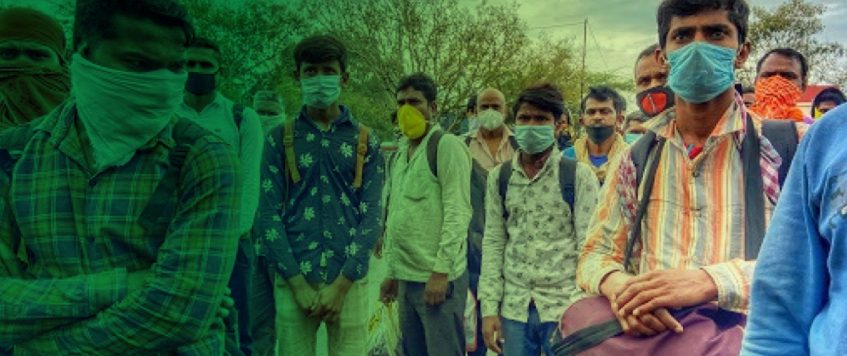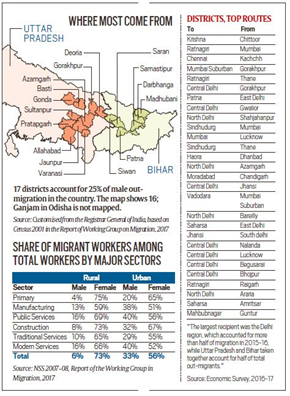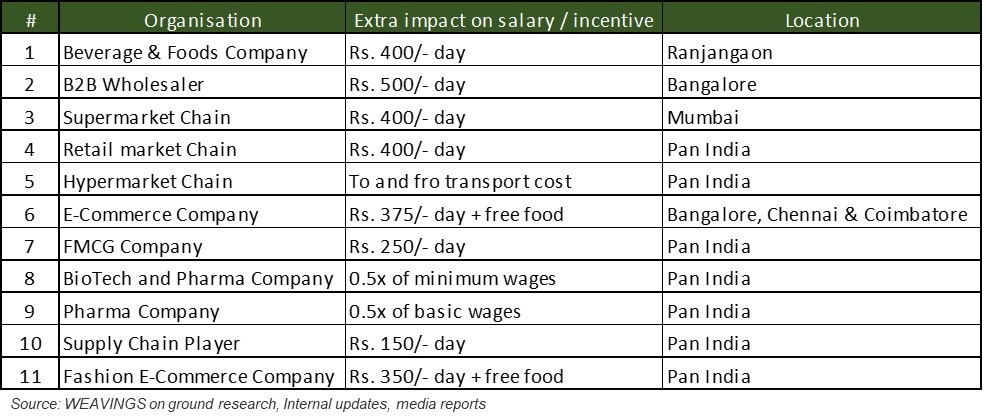
Executive Summary:
- Business leaders face unprecedented situations as the COVID-19 pandemic continues, intensifying the need to holistically evaluate all the opportunities and risk to remain resilient.
- With the current migrant exodus, Labour adequacy would be a critical differentiator as the lock-down eases and operations start picking up.
- Labour unavailability directly impacts the ability to fulfill demand and hence results in a loss of revenue in these difficult times.
- Companies need to adopt a systematic and proactive approach to attract back and retain the much-needed workforce for operations continuity.
- Innovative ways of productivity linked incentives, provision for accommodation, food and transportation, health and safety assurance with genuine care for people would pave the path of workforce assurance as needed in this complex and uncertain time.
- While there would be an additional cost impact to provide for the labour welfare, the risk of revenue and productivity loss would be much higher in comparison.
- Moreover, only the companies sensitive to its workforce would be able to win back the trust of its customers.
Countries that have managed to control the spread of COVID-19 are seeing a gradual movement back to normalcy. Within India, the major consumption centres are expected to recover faster. However, the larger question that the country is going to face in the coming days is – Will the industry be able to fulfil the demand?
The Indian industry is staring at one of its biggest challenges – Labour availability. India has always been seen as a place with abundant supply of cheap labour and hence the industry has never experienced such a challenge in the past and is largely under prepared to handle the same.
Possibility of losing sales, in these critical times, due to shortages in manpower in its supply chain at its factories and warehouse, which traditionally has been labour intensive, is something that is going to keep corporate India awake at nights in the days to come.
COVID-19 has changed migrant workforce landscape in India:
The nationwide lockdown in India, which started on March 24 to curb the spread of coronavirus, has impacted nearly 40 million internal migrants, according to World Bank.
Lockdown, loss of employment, social distancing and fear of corona have forced majority of migrant workforce to reverse migrate to their natives.

India has no central registry of migrant workers despite passing legislation 40 years ago to establish such a database, However estimates suggest that Uttar Pradesh and Bihar account for the origin of 25% and 14% cent of the total inter-state migrants, followed by Rajasthan and Madhya Pradesh, at 6% and 5%. This translates to around 4-6 million people would be wanting to return to Uttar Pradesh, and 1.8-2.8 million to Bihar. Another 700,000 to 1 million would be wanting to return to Rajasthan and 600,000-900,000 to Madhya Pradesh.
On one hand we have the biggest humanitarian crisis looming on us and on other hand most of the Indian business sectors with high concentrations of migrant workers —construction, manufacturing, services and logistics have been seriously affected by this exodus of migrants.

The normal migration corridors are likely to change. Long-distance migration will be affected. Somebody coming from the northeast to Kerala in the south may not come anymore.
Communities where we operate are also reeling under fear of migrant labours adding to the COVID spread and hence not welcoming outside workforce to enter the locality.
Migrant labour themselves are too scared of their own health and safety and are pivoting to stay closer to their natives rather than risking their lives.
Depending upon how they were treated during the lockdown, chaos and pain of getting back home and emerging new opportunities in domicile states, many of these migrants may never return back.
Reopening of the businesses would require the labour to be available and going by the current realities there may be a major supply crunch in the labour market for a stretched period.
Early impact of this labour supply crunch has already started becoming visible. Many of the businesses which could open up their businesses during the period, have already been forced to pay extra salaries and incentives to get the required manpower.

One may argue, that this may be a temporary phase driven by lockdowns and operating restrictions, let’s not forget the possibility of a second wave of infections and monsoons. For atleast next two quarters the situation is going to remain uncertain and hence the availability of labour. Oct-Dec 20 period becomes highly critical as the consumption may get a boost during the festival times and labour unavailability during this period will jeopardise the little opportunity to review the revenue growth.
Labour unavailability directly impacts the throughput, risking the ability of business to fulfil the demand (and may be pent up demand). For every 100-basis points reduction in labour availability, throughput productivity will decrease by 125-150 basis points.
In the above context, the pertinent question that arises is what can organisation do differently in order to have the workers back, offering a safer and healthier work environment and ensuring business continuity thereby creating a win-win scenario.
We need a proactive approach to attract, retain and win the confidence back of these migrant workforce
After taking into considerations the likely migrant workforce scenario, evolving govt. guidelines on COVID measures, social distancing norms, and possible uptick in demand, we have summarised a set of recommendation for workforce assurance while living with COVID.
- Increment in Daily/monthly wages
We have already mentioned the incremental salaries, many companies are paying currently.
As per a recent report by Trading Economics, wages in the long-term, the India Average Daily Wage Rate is projected to trend around 372.33 INR/Day in 2021 and 397.00 INR/Day in 2022.
Govt. has already made provisions in its latest stimulus package for migrants to increase the wages by 10-15% and its highly likely that the rates may be increased again by 15-20% in a couple of months.

Organisations can consider this and also make relevant increase in the daily wages to its workers given the current crisis and ensuring that they are retained.We recommend a location specific increment wage structure with productivity linked incentives.
2. Hygiene Food, Transport & Accommodation
The workers also need to be provided with hygienic and health food to ensure they don’t have to spend on food every day or go out of the work premises everyday looking for food. Right nutrition assurance will ensure their good health as well leave them with adequate money to take care of the families.
Most of the migrants live in rented accommodations in closed and unhygienic conditions and usually in groups. Many organisations are arranging for accommodation of its workforce within the work premises or close by to ensure that they have safe environment and do not have to travel hence reducing the COVID risks. Given the local transportation may be restricted for some time and even after the risk of COVID spread is high, many companies have made arrangement for local transportation of the workers.
We recommend provision of functional shared accommodation or rental reimbursements, provision for two healthy meals at the workplace and company transport to and fro from their accommodation.
3. Job Security
In uncertain times, everyone is looking for some sort of assurance. The assurance not only around jobs but also for safety of workers. Something that can provide a calming impact and revive sentiment.
We recommend constant communication and assurance around job security linked with productivity and ability of the organisation.
4. Safe working environment/ PPE
Need for personal hygiene, sanitation and safety is at the highest; Providing for the workers to get all the required safety equipment like mask, hand sanitizers, gloves & temperature screening on arrival to reduce the fear of being infect with the virus.
We recommend provision for adequate PPE/ Sanitation and Hygiene as the minimum operating standard across all the facilities.
5. Periodic Health Check-ups, OTC medication support and Health Insurance
While the health check-ups and temperature monitoring is a requirement for all at this stage of pandemic, regular health check-ups and OTC medication support need to become part of organisation health protocols. Most of the workers are at the risk of contracting the virus and have been asking for assurance on medical expenses and life risks due to working during COVID.
We recommend quarterly health check-ups for all migrant workers at company cost, provision for OTC medication kit and an adequate life and health insurance coverage (COVID specific) for a cover of 3 lakhs for the employee and their family.
Workforce wellbeing and assurance can be achieved at a marginal cost by implementing the above recommendations.
Executing the proposed value proposing would require an additional outlay of Rs. 5-10,000 per associate per month depending upon the locations and extend of benefits offered.
This cost impact is adequately negated by the improved throughput and productivity. In absence of these measures we will end up paying more in terms of throughput costs. Below table clearly illustrates the impact of total cost as % of sales in the three scenarios.

Envisaged Benefits
- Assurance of labour availability
- Assurance of throughput productivity
- No loss of Sales due to manpower unavailability
- Compliance with Govt. directives
- Employee Health and Safety
- Moral and Ethical Satisfaction
- Showing our genuine care and affection for the people who are foundation of our businesses.
Conclusion
COVID-19 has changed the way of working and more importantly the operating cost structures. Navigating to the new normal would require us to revisit all business cost assumptions and proactively make appropriate and adequate provisions to be better prepared than competition to fulfill market demands and capture a larger market share.
Let’s partner together and act to assure value creation for all our stakeholders.